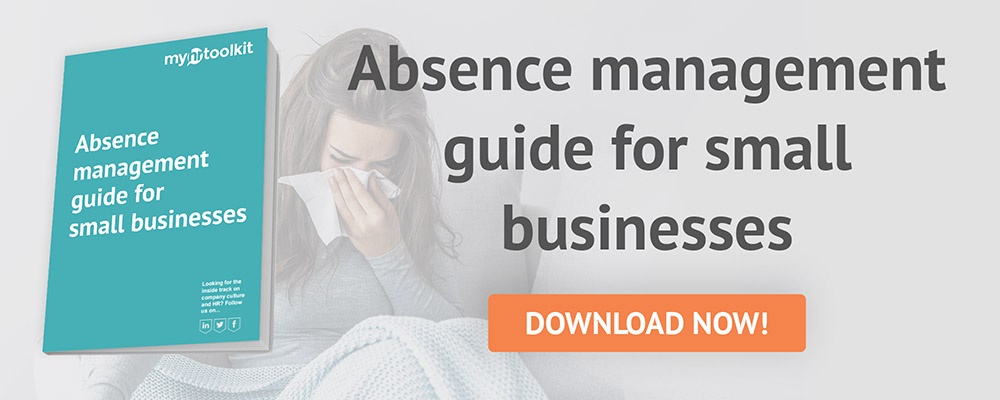One of the challenges of running a business is dealing with staff absences. When staff are absent, work doesn’t get done and that can delay big project deliveries, work completion, and company growth.
There are many reasons why employees might be absent from work. It could be sickness, they may be required to isolate due to COVID-19 testing, they may be taking long-term leave to receive treatment of some kind, or they may be on maternity or paternity leave. Alternatively, you might be dealing with a troublesome employee who simply disappeared from work for a couple of days unauthorised, only to return as if nothing had happened.
Understanding how to manage staff absences (especially in times of Covid-19) and doing so in a way that is both authoritative and supportive can be difficult. But it’s not impossible. In this article, we will be sharing our five tips for dealing with absence management so you are equipped to tackle this recurring challenge with confidence.
1. Stay in contact with absent staff

Whether your employee is absent as a result of a personal family matter or they are just resting due to a winter cold, it is important to remain in contact. What many employees struggle with is the feeling of isolation that often comes when they take a leave of absence. Many employers neglect to make any contact with their absent employees, forgetting to check-in with a quick text or phone call.
Open and honest communication is one of the best ways to support employees through their time of absence, especially if they are absent long-term. It helps provide assurance that you are there for them and available to offer any support or assistance, should they need it. What’s more, staying in contact with absent employees can also be helpful for you. It helps keep an open line of communication so you can stay up-to-date with their progress and get a feel for when they may return to work.
We recommend writing a contact timescale into your staff contract or company handbook that is applicable to staff absences. This gives you permission to get in touch after a certain time period and without feeling like you are interfering. Alternatively, if the absence is the result of a more sensitive topic such as a family emergency, the best way to achieve a healthy balance is to agree with said employee a contact timescale that works for you both and then ensure it is followed. The sooner you put these frameworks in place, the more effective staying in contact will be.
2. Introduce a structured return to work

All work absence, whether it’s a couple of days or multiple months, can make returning to work a little nerve-wracking. Often, employees worry they have fallen behind on their workload and they can become stressed as they consider just how much work they will have to catch up on.
Regardless of the length of their absence, the most helpful way you can tackle this challenge is by introducing a structured return to work. The first thing that should happen upon their return is they should be met by their manager for a quick catch-up. This is an excellent way to check-in with the returning employee, discuss any support they may need, and catch them up on everything that happened in their absence.
Track all types of staff absence with the documentation and calculations you need by using an absence management software system designed for SMEs.
In most cases, this will involve a simple catch-up over a coffee. However, in the case of longer-term absences or anything related to COVID-19, it may be necessary to discuss the support required. This can include mental health issues, disability access, changing work patterns for new parents, employee assistance programmes, and more.
A structured or phased return to work allows time for these important discussions and ensures the returning employee has everything they need to get back on track.
3. Allow for a shorter working week

Shorter work weeks are becoming more common and are particularly popular among employees. You could consider introducing a shorter work week in various ways. For example, you could let your employees take a half-day on Fridays, you could allow for flexible working where employees choose their own schedules to fit a particular number of hours, or you could reduce working hours across the board by 20% (given the rising popularity of the 4 day working week).
Introducing a shorter working week is a great way to deal with the problem of workplace absenteeism. According to a 2021 study that followed Swedish workers for a decade, reduced working hours helped to reduce employee stress, exhaustion and negative emotions - all which had previously played a part in staff absenteeism. Introducing a shorter working week is a great way to manage and potentially reduce absences in your workplace.
4. Focus on creating a happy work culture

Your work culture has a significant impact on the happiness and productivity of your employees. If you want to reduce staff absences, you need to create a happy work culture. The happier your work culture, the less staff absences you will see.
Many organisations are focusing their efforts on transforming their workplaces to make them feel more welcoming. They are also developing managers’ skills and people management abilities through mental health training days and promoting an open culture of communication.
Richard Branson famously said, “clients do not come first. Employees come first. If you take care of your employees, they will take care of the clients.” Staff attendance, attitudes, and productivity all improve when employees are positively engaged as part of a happy work culture. If you want to reduce staff absences and make your workplace a better place to work, it’s time to take a closer look at your culture and start making changes.
Preventative measures can be put in place as part of a culture of health and safety, for instance around the COVID-19 pandemic; many Government-approved testing providers (such as C19 Testing) are able to come into your place of work and ensure that your business is COVID-secure to help combat any further spread of the virus - resulting in reduced staff absence.
5. Treat employees as individuals

When you run a business, whether it has 10 employees or 10,000, there is always so much to do. Between client meetings, project proposals, sales calls, and all of the admin, it can feel like you are fighting for time in the day. As a result, it can be easy to neglect the needs of your employees.
Each of your employees is an individual. They have their own life with their own worries and struggles and triumphs. Part of running a successful business involves getting to know your employees on a personal level. What do they enjoy? Do they have a family? What are their interests? How can you offer support? What are their career goals?
Treating employees as individuals and developing a personal relationship with each one of them is the best way to reduce absenteeism in the workplace and cultivate a healthier, happier workforce. You have to care. If you care, you will not only have a healthy and thriving work culture but you will have an incredibly successful business.
Final words
So, there you have it: staff absence and our 5 tips for dealing with it. We hope our advice has been helpful and that each point has given you something to think about. Workplace absenteeism is a challenge for all business owners; however, there are steps you can take to deal with it in an understanding and sensitive manner.
Read more from the myhrtoolkit blog
Questions to ask your employee in a long-term sickness meeting
How to calculate a sickness absence percentage for employees

Written by Gemma Hart
Gemma Hart is an independent HR professional working remotely from as many coffee shops as she can find. Gemma has gained experience in a number of HR roles but now turns her focus towards connecting with a wider community and sharing her thoughts and advice on workplace wellness and engagement within companies.


 Holiday Planner
Holiday Planner Absence Management
Absence Management Performance Management
Performance Management Staff Management
Staff Management Document Management
Document Management Reporting
Reporting Health and Safety Management
Health and Safety Management Task Management
Task Management Security Centre
Security Centre Self Service
Self Service Mobile
Mobile




